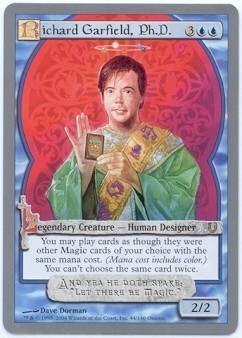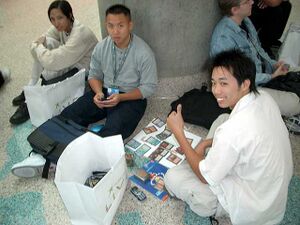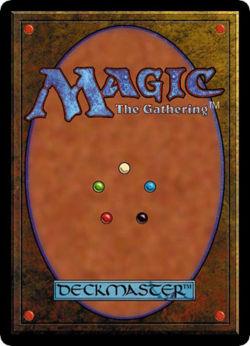Magic: The Gathering: Difference between revisions
1d4chan>Myomoto |
1d4chan>Myomoto No edit summary |
||
| Line 36: | Line 36: | ||
*Planeswalker - One of the newer and more controversial card types, the Planeswalker is similar to an enchantment. Planeswalkers come into play with a certain amount of loyalty counters on them. Once per turn a planeswalker can use one of its activated abilities during his main phase whenever he may play a sorcery, either adding or subtracting the indicated amount of counters. A planeswalker can be targeted for either spells or abilities that deal damage, and can be targeted in an attack phase like a player. For each damage a planeswalker takes, instead remove that many loyalty counters. If a planeswalker has no loyalty counters left on it, it is destroyed. | *Planeswalker - One of the newer and more controversial card types, the Planeswalker is similar to an enchantment. Planeswalkers come into play with a certain amount of loyalty counters on them. Once per turn a planeswalker can use one of its activated abilities during his main phase whenever he may play a sorcery, either adding or subtracting the indicated amount of counters. A planeswalker can be targeted for either spells or abilities that deal damage, and can be targeted in an attack phase like a player. For each damage a planeswalker takes, instead remove that many loyalty counters. If a planeswalker has no loyalty counters left on it, it is destroyed. | ||
== | ==Colours of magic== | ||
[[Image:Magic Card Back.jpg|thumb|The back of a Magic card.<br> It features the trademarked pentagram of the colours. The pentagram is set up in such a way that colours that have parts of their philosophies in common are adjacent to each other, whereas colours that oppose each other are positioned opposite of each other.]] | [[Image:Magic Card Back.jpg|thumb|The back of a Magic card.<br> It features the trademarked pentagram of the colours. The pentagram is set up in such a way that colours that have parts of their philosophies in common are adjacent to each other, whereas colours that oppose each other are positioned opposite of each other.]] | ||
As well as having different types of cards, the game of Magic also have 5 different colours to choose from when build a deck. | As well as having different types of cards, the game of Magic also have 5 different colours to choose from when build a deck. | ||
It is important to have the appropriate type of land for the colour of magic that you are playing with, since only a mountain can produce red mana, which is typically needed to play any red spell. | It is important to have the appropriate type of land for the colour of magic that you are playing with, since only a mountain can produce red mana, which is typically needed to play any red spell. | ||
The colours are associated in the | The colours are associated in the colour pie, which determines what kind of effects a card can have, depending on its colour, this is to ensure that the colours feel different to play and that there is a point of having the different colours in the first place. | ||
*White - This is the goody-two-shoes of the colour pie, white is able to prevent large amounts of damage to its creatures, as well as having a general philosophy of having a large amount of small creatures, instead a few big ones. White normally embodies law, order, good, community, healing, and light. The symbol for white,is a sun. Its land is a plains. | *White - This is the goody-two-shoes of the colour pie, white is able to prevent large amounts of damage to its creatures, as well as having a general philosophy of having a large amount of small creatures, instead a few big ones. White normally embodies law, order, good, community, healing, and light. The symbol for white,is a sun. Its land is a plains. | ||
Revision as of 18:56, 30 June 2008


Magic: The Gathering (or just "Magic") is a collectible card game created by Richard Garfield and introduced to neckbeards everywhere in 1993. Despite the amount of RAGE the game has created over the years, it's still going strong. The game is currently in it's 15th year of production with a large competitive following, consisting mostly of 40-year-old basement dwellers. Magic is notable for being the first CCG to make it big, and its influence can be seen in almost every CCG since.
Objective of the game
Each player starts with a life total of 20, it is the goal of the game to reduce your opponent's life to 0 or less. The most common way for this is combat between both player's creatures, which all have the primary attributes of power/toughness, displayed at the lower bottom corner of the card. Power determines the amount of damage the creature can cause in combat, whereas toughness is how much damage it can take before it is destroyed. Damage assigned to a creature is cleared at the end of each turn, meaning that if a creature isn't killed by the amount of damage it has sustained, it'll return to its full toughness at the end of the turn. This means that the same creature will often participate in several combat steps before it is finally killed. Damage assigned to players however, is never healed by any other means than other cards that give the player an amount of life upon being played. All the creatures a player wishes to use in an attack has to be declared at the same time, meaning that it is not possible to attack with one creature, see how it goes, attack with another when you're sure the cost is clear etc.
In order to play cards, such as creatures, the player first have to play land cards. Normally you can only play 1 land each turn, meaning that players will generally start playing their more powerful spells later in the game, since these are more expensive in mana to play. Players are able to draw mana from their lands, it is indicated that a land has been exhausted of mana by tapping it, that is, turning it 90 degrees to the right. Creatures are also tapped when they are used for attacking. All tapped cards are untapped in the start of a player's turn. This means you can attack with your creatures once each turn, and spend mana from a land once each turn.
Types of cards
The game of Magic contains several different types of cards:
- Lands - These are the player's most basic resource, and they allow the player to play their other cards that have a mana cost.
- Creatures - Creatures are the players soldiers and guardians, they primarily participate in combat, although as with all things in Magic, there are many exceptions this.
- Enchantments - These are raw magic that you create, they can do all different kinds of things, and generally have a constant effect on the game, until they are destroyed by your opponent. There are global and local variants, the local being called auras, these are attached to other cards in play to enhance them or weaken them. A lot of competitive players dislike auras since they are destroyed if their 'host' is destroyed, meaning that it is easier for your opponent to make a lot of you cards obsolete by destroying one card.
- Sorceries - These are spells that you can only cast on your own turn, they'll have some kind of immediate effect on the game, but they are not persistent like enchantments. This means that it is common for sorceries to simply just destroy something else in play or to give a temporary boost to a creature or something like that.
- Instants - Just like sorceries, however an instant can also be played in an opponent's turn, they'll often do the same as sorceries, but stuff like counter magic, that is a spell that prevents your opponent's spell from resolving, are only instants.
- Artifacts - All kinds of magic items, like a staff or some other kind of stuff. Normally this is stuff for the player himself, but some artifacts can be equipped by the player's creatures, making them work like auras, only they do not need a 'host' to be in play, and as such are a lot more persistent than auras. Some artifacts are also creatures, this is stuff like golems or other kinds of magical constructs.
- Tribal - A newcomer to the card types, a Tribal card gives a creature type to a noncreature card. For example, a card that would allow you to destroy a goblin card would work on any goblin creature, as well as a Tribal Enchantment - Goblin.
- Planeswalker - One of the newer and more controversial card types, the Planeswalker is similar to an enchantment. Planeswalkers come into play with a certain amount of loyalty counters on them. Once per turn a planeswalker can use one of its activated abilities during his main phase whenever he may play a sorcery, either adding or subtracting the indicated amount of counters. A planeswalker can be targeted for either spells or abilities that deal damage, and can be targeted in an attack phase like a player. For each damage a planeswalker takes, instead remove that many loyalty counters. If a planeswalker has no loyalty counters left on it, it is destroyed.
Colours of magic

It features the trademarked pentagram of the colours. The pentagram is set up in such a way that colours that have parts of their philosophies in common are adjacent to each other, whereas colours that oppose each other are positioned opposite of each other.
As well as having different types of cards, the game of Magic also have 5 different colours to choose from when build a deck. It is important to have the appropriate type of land for the colour of magic that you are playing with, since only a mountain can produce red mana, which is typically needed to play any red spell. The colours are associated in the colour pie, which determines what kind of effects a card can have, depending on its colour, this is to ensure that the colours feel different to play and that there is a point of having the different colours in the first place.
- White - This is the goody-two-shoes of the colour pie, white is able to prevent large amounts of damage to its creatures, as well as having a general philosophy of having a large amount of small creatures, instead a few big ones. White normally embodies law, order, good, community, healing, and light. The symbol for white,is a sun. Its land is a plains.
- Blue - Blue is the logic and more pure wizard like colour, as such blue is the best colour at stuff like counter magic, drawing cards, and being a general pain in the butt with different kinds of minor trickery. Blue concerns itself with such things as logic, law, science, knowledge, divination, and air. The blue symbol is a drop of water. The blue land is an island.
- Black - Black is the more diabolical of the colours, black often has the ability to emulate all the other colours to a lesser degree, and often at a cost of the player's own life total. Black contains such things as sickness, destruction, evil, necromancy, divination, darkness, and corruption. A skull is the symbol for black. The black land is a swamp.
- Red - Red is the colour of passion and rage, as such red often contain some of the more self destructive cards of the colours, but this is often a fair price for the cards effect. Some of the most powerful sorceries are found in red. The domain of red is such things as speed, destruction, fire, lightning, dragons, and recklessness. Red's symbol is a ball of fire. The red land is a mountain.
- Green - Green associates itself with nature and cycle of life, it is commonly the colour to have the most powerful creatures of them all. Green generally contain cards that can increase the strength of your creatures, giving you more mana by putting more lands into play on the same turn, converting your mana into the other colours of mana, regeneration, and making your big creatures stronger from having a bunch of smaller creatures cooperate to help them.
It is possible to build decks that are a mix of two colours, in fact many spells that require to different colours of mana exist. It is however not advisable to have more than a maximum of 3 colours in a single deck, since it'll begin to become a problem to get access to all 3 colours of mana during play, meaning you'll end up sitting there and taking it like a bitch.
Players
The developers of Magic have put out their 3 archetype players:
- Timmy - The classic little boy, likes that cool big monsters and all the other cards with huge effects, despite the fact that these often suck because they have a too high mana cost to have any real effect on the game because they can only be played so late.
- Johnny - A combo player, these are the guys who'll spend days looking through cards to find a bizarre combo that makes them win the game. They often end up building decks that doesn't participate in the game itself, and are more oriented on getting their combo into play, turning the game into a sort of solitaire.
- Spike - The competitive player of the bunch. They'll build decks to win and only play to win, almost none of them are in it for the fun, and often turn the game into an obnoxious competition, even outside of tournaments.
The three archetypes mix and match, meaning that it is possible to be a Johnny-Timmy player, aiming to make some kind of combo that'll give you a million life and an army of 100/100 creatures or some other kind of stupid nonsense.
Recently, it has come to light that there are 2 more archetypes, though these can't be considered proper archetypes. The types here are on a seperate axis than the aforementioned. They are as follows:
- Vorthos - Vorthoses care about flavor and the story part of the game. They'll build a deck that re-enacts the forces Urza rallied to fight the phyrexians. Fluff is of key importance in the mind of a Vorthos. Stories, art, flavor text, and block novels are all things that a Vorthos focuses on.
- Melvin - On the opposite side of this spectrum lies Melvin. Melvins love to deconstruct the rules, find out why things tick. A Melvin will base a deck on retarded shit like banding, or some sub-clause of an obscure part of the comprehensive rules. Melvins love reading the logs and development process of various cards.